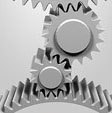 Residual Stress Effects
Residual Stress Effects |
Residual Stress Effects
Residual stresses play an important role in the manufacture and
performance of gears. Residual stresses created by machining and heat
treating operations are responsible for much of the distortion that
occurs during manufacture.
The residual stress distribution in finished gears can determine whether
or not the gears will survive in service. Residual stresses (either
favorable or unfavorable) are induced mechanically, thermally, by phase
transformation, or by modification of surface chemistry (such as by
nitriding). Each of these, singularly and in combination (such as by
carburizing), can affect the degree of in-process distortion and the
residual stress state present in the finished
parts. The following sections briefly discuss the causes of each type of
induced residual stress.
- Mechanically Induced Residual Stresses.
There are two types of mechanically induced residual stresses, machining
stresses and finishing operation stresses. Machining stresses are
created by the cutting of the gear shape and can be either beneficial or
detrimental. Parts given a final
heat treatment
after finish machining
may have the gross residual stresses from milling, turning, and hobbing
minimized by intermediate stress relief heat treatments in order to
prevent significant distortion during the final heat
treatment. Machining cuts taken just prior to final heat treatment must
be light enough so as not to create significant residual stresses.
Grinding after final heat treatment must be performed very carefully
since it can create residual tensile stresses in the surface of the
gear
which can adversely affect performance. Lapping, honing or careful
grinding of gears
after final heat treatment maintains beneficial compressive residual
stresses. Finishing operations such as
shot peening and roller
burnishing also impart beneficial compressive residual stresses when
properly controlled. These operations are typically performed on
finished
gears to improve the pitting and surface bending fatigue
resistance.
Use of cubic boron nitride (CBN) grinding may have a favorable effect on
the residual stresses in the finished gear. Under extreme grinding
conditions, however, CBN grinding may also induce surface tempering
residual tensile stresses. Other hard gear finishing methods (e.g.
skiving)will need to be individually evaluated as to effect on residual
stress levels.
- Metallurgically Induced Residual Stress.
The other types of residual stress, although quite different, can all be
categorized as being metallurgically induced. Thermal, phase
transformation and modification of surface chemistry stresses result
from heat treatment of steel.
- Thermal and Phase Transformation Stresses.
Thermal stresses result from the heating and cooling of materials.
Quenching, one type of thermal stress, can also be considered a phase
transformation stress. Quenching, particularly fast quenching to form
martensite, generates both thermal and phase transformation stresses.
For example, two types of residual stress patterns can form on quenching
of a round bar. The most common type of residual stress pattern in small
diameter bars is a tensile stress at the surface and a compressive
stress at the center. This stress pattern results from the surface of a
bar cooling faster than the center. The phase transformation to
martensite creates volume expansion producing tensile stress at the
surface. This in turn creates a compressive stress at the center.
The second and opposite type of residual stress pattern occurs during
quenching of large diameter bars. In this situation, the surface hardens
but the center remains at an elevated temperature for some extended
period of time. The thermal contraction exceeds the expansion of the
transformation to martensite, setting up residual tensile stress at the
center
and residual compressive stress at the surface.
These two types of stress patterns are determined by two variables, size
of the bar and speed of the quench. When the sum of these two variables
is large, for example large diameter bar with a fast quench, the stress
pattern will be of the second type with residual tensile stress at the
center and residual compressive stress at the surface. When the cooling
rates of the surface and center are similar, the thermal contraction can
not overcome the expansion from the martensitic formation and residual
tensile stress will form at the surface, while the center will consist
of residual compressive stress.
- Residual Stresses by Modification of Surface Chemistry.
This
type of residual stress must also be considered in conjunction with
thermal residual stress because modification of surface chemistry
requires heating, and heating can introduce thermal stresses, which must
be taken into account. Carburizing, the most common type of surface
chemistry
modification, will serve as a good example of these types of residual
stresses. In quenched
carburized steels, the transformation temperature
of austenite to martensite in the core occurs at a much higher
temperature than the case, and as discussed in the previous section, the
austenite to martensite transformation creates a volume expansion.
Therefore,
as the part is cooling, transformation begins in the core and moves
outward toward the case setting up tensile stresses in the core. The
expansion of the case is opposed by the previously transformed core
imparting beneficial compressive stresses in the case. Compressive
stresses in the case help reduce surface pitting caused by tooth contact
stress above and below the pitch line. They help counteract tensile
stresses caused by bending in the root.
 Racks |
Cylindrical Gears |
Bevel Gears |
Worm and Worm Gears |
Non Circular Gears Racks |
Cylindrical Gears |
Bevel Gears |
Worm and Worm Gears |
Non Circular Gears
Home |
Special Application Gears |
Read Before Inquire |
Gear Info |
Site Map
Tel: 86-10-6492-5308 | Fax: 86-10-6492-5744 |
E-Mail "GEARX"
Remember to bookmark this web site for your future convenience!
Copyright by Beijing GEARX Limited. All rights reserved.
| 